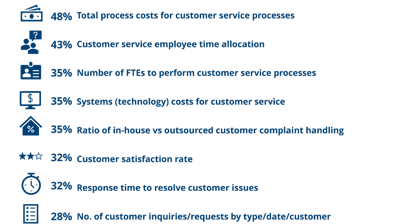
Customer expectations have changed as a result of recent disruptions and global health concerns like the COVID-19 pandemic. Through its customer service research, APQC finds that nearly seven out of every 10 respondents are seeing their customers turn personal consumer experiences into business expectations. This includes the “Amazon effect,” which leads customers to demand faster orders and increased order visibility. Six out of ten respondents also see orders shifting to digital channels and an increased desire among customers for consistency across channels.
Excellence in customer service is critical for retaining customers and maintaining a competitive advantage in the face of these changing expectations. Yet APQC finds that many customer service organizations have picked key performance indicators (KPIs) that are inward-looking, lack customer focus and fail to align with leadership priorities.
Leadership priorities and common customer service KPIs
As part of its customer service research, APQC identified the most important goals for senior leaders when it comes to customer service support for business strategy. Improving customer satisfaction and improving customer response time topped the list, chosen by 45% and 37% of respondents respectively. These top two goals align well with changing customer expectations for faster service and more consistency across channels.
Unfortunately, there is a disconnect between what senior leadership is looking for and the ways in which customer service is measured in many organizations. When APQC identified the most common KPIs for the customer service function, we found that internally focused KPIs like total process cost for customer service topped the list (Figure 1).
Top Eight Key Performance Indicators (KPIs) Used to Track and Evaluate Success in Customer Service
 Figure 1, N=289
Figure 1, N=289
Measures that focus externally on the customer experience and that speak directly to customer service success from the customers’ perspective do not appear anywhere in the top five KPIs. Customer satisfaction rate—the highest priority for leaders—is sixth and is only used by about a third of surveyed organizations.
In light of these findings, it is clear that many organizations have an opportunity to consider their customers’ perspective more closely when selecting customer service measures. An organization that prioritizes lower customer service process costs (the most common KPI) may actually be at risk of losing customers if lower process costs mean longer wait times or less responsive customer service representatives.
Next steps
APQC recommends that customer service teams select a balanced mix of measures that speak not only to internal process cost or time allocation but also external customer experience outcomes like retention and net promoter score. More fundamentally, it is critical that measures of success —whether for customer service or any other area— are aligned with what matters most to leaders and to the business.
One of the most effective ways to ensure that KPIs align with strategic priorities from leaders is to ask them directly. These conversations and documents, like your organization’s strategic plan, are helpful for getting a sense of broader organizational goals around which your customer service team can align.
Once you speak with senior leaders and review any relevant strategy documents, work to close any gaps between these broader organizational priorities and your customer service measures. When these measures are aligned, senior leaders will be able to see the value that your customer service function drives much more clearly. At the same time, your customer service team will develop a better understanding of how their work contributes to a broader ecosystem that collectively drives enterprise value.




















![Pros To Know 2026 [color]](https://img.sdcexec.com/mindful/acbm/workspaces/default/uploads/2025/08/prostoknow-2026-color.mduFvhpgMk.png?ar=16%3A9&auto=format%2Ccompress&bg=fff&fill-color=fff&fit=fill&h=135&q=70&w=240)